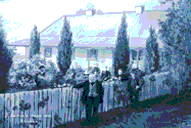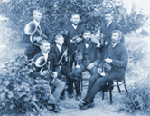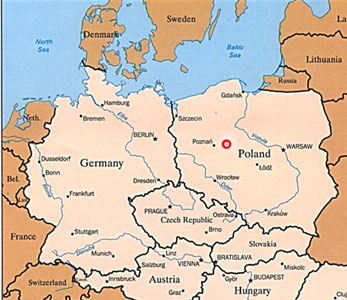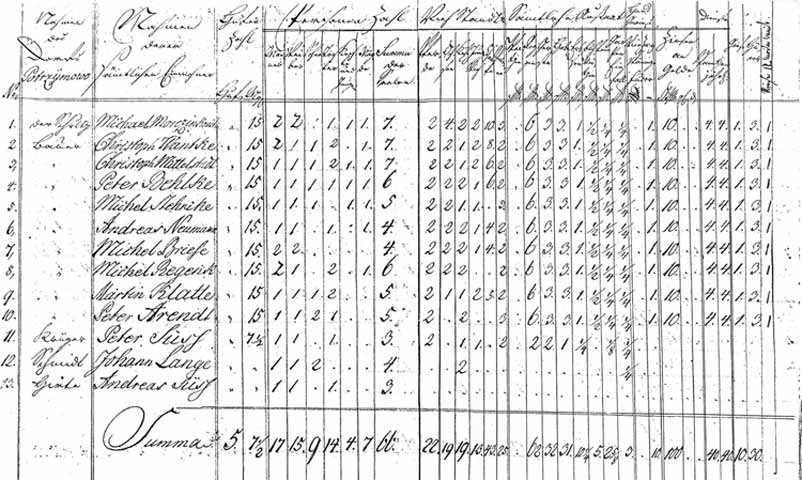 |
 |
 |
 |
 |
A glimpse into the life of Michael Briese 1738-1819: our earliest known Briese ancestor
Michael Briese was the grandfather of Johann Ludwig Briese, who emigrated to Australia in 1855. There are few records of his life; he is directly mentioned only once in the Czerniejewo Evangelical Parish Book 1, when he died on 4 December 1819, at the age of 81. However, the following year he is referred to as the late father of Christoph Briese in the Parish record of marriage of Christoph to Katarina Steinke (the parents of Ludwig), thus providing the link to the descendants of Ludwig. There is no record of his wife, but they had at least two children, Anna Johanna, and our ancestor Christoph. He was described in Parish Book as an Eigenthümer (a property owner) from Potrzymowo, a small village to the east of Czerniejewo. From the death record we can assume that he was born in 1738, but the place of his birth remains a mystery. It may be that the Briese family had lived in Potrzymowo for several generations or they may have moved there recently. It is known that German families in nearby villages (e.g. the grandparents of Michael's daughter-in-law) settled in the nearby village of Gembarczewo in the mid-1700s at the request of the local Polish nobility 2. This resettlement followed depopulation of the region due to cholera and war.
|
Michael lived through a period of intense political turmoil 3. The region where he lived is now in Poland, and at the time he was born was known as Wielkopolska (Greater Poland), part of the kingdom of Poland-Lithuania. However, the great powers of the time, Prussia, Austria and Russia had designs on Poland. In 1772, they each annexed part of the Polish territory in the first partition. In 1793, the second partition saw the Russians taking more territory in the east and the Prussians more in the west, including the region where Michael Briese and his family lived. This region became known as South Prussia. The Poles revolted briefly under the leadership of Tadeusz Kosziusko, but were finally beaten and in 1795, the three great powers completed the annexation of Polish territory by dividing up the remainder. However, this was short-lived, as Napoleon stepped into the picture and, with the Poles as allies, defeated the Prussians and Austrians in 1805. Napoleon, however, was more interested in expanding his empire than liberating the Poles and the homeland of Michael Briese became part of the Grand Duchy of Warsaw, a state subservient to France. The defeat of Napoleon in 1815 saw a new reorganization of boundaries and, once again the Brieses found themselves within Prussia, in what became the Province of Posen.
|
 Location of Potrzymowo (red circle), home of Michael Briese, transposed onto a map of modern Europe |
Soon after annexing South Prussia, the Prussians conducted a census of landholders. The 1793-94 Land Registration Records of South Prussia 4 included the inhabitants of the village of Potzrymowo and give a fascinating insight into the life of Michael Briese. According to these records there were 13 landholders in Potryzymowo, with 66 people living on the properties. The Schulze (village mayor) was Michael Morczinkowski; Christoph Wandke, Christoph Mittelstadt, Peter Behlke, Michel Stehnike, Andreas Neumann, Michel Briese, Michel Regenik, Martin Klatte and Peter Arendt were listed as Bauer (farmers); Peter Süss was the Krüger (innkeeper), Johann Lange the Schmied (blacksmith) and Andreas Süss, the Hirt (herdsman).
Transcript of Vol. 54 p 2105 of the "1793-94 South Prussian Land Registration Records". Michael Briese is listed as No. 7 in the village of Potrzymowo. |
Like all the other farmers, Michael Briese had a Gut (property) of 15 Morgen in area (a bit less than 4 ha). A Morgen was derived from the area that could be ploughed in one morning (Morgen). The records list 2 males and 2 females living on his property. There were no hired workers listed, although some of the other landholders did have one or two living on their farms. The livestock owned by Michael Briese comprised, 2 horses, 2 oxen, 2 cows, 1 yearling cow, 4 sheep and 2 pigs. In addition he was attributed with 6 units of rye, 3 of barley, 3 of oats, 1 of peas, ½ of buckwheat, ¼ of hay and ¼ planted to a garden. It is not clear what the units are, but they could be Morgen, as the total comes to 14, and we know that the area of his farm was 15 Morgen. Clearly the life of a small farmer in South Prussia in the 18th century was very different from that which the descendants of Michael Briese know in Australia today. |
Footnotes 1 Czerniejewo (also known as Schwarzenau at the time) was the major centre for a number of small farming villages around it, and the Evangelical Parish included people from the town and surrounding villages, such as Potrzymowo and Genbarczewo). Parish records were obtained on microfilm from LDS, Salt Lake City. 2 K. Lück (1981) Die Bauern von Grünfeld (=Gembarczewo). pp 246-247 of "Deutsche im Gnesener Land" edited by W. Gerke. 3 A good summary of the history of this area can be found at http://www.nationmaster.com/encyclopedia/History-of-Poland. 4 A summary of the 1793-94 Land Registration Records of South Prussia was complied by Reuben Drefs and and information on how to obtain further details can be found at http://genealogy.drefs.net/ |
This site powered by The Next Generation of Genealogy Sitebuilding ©, written by Darrin Lythgoe 2001-2024.

